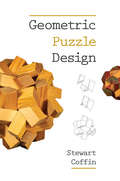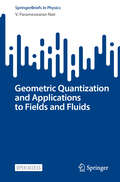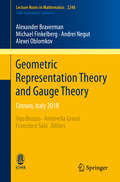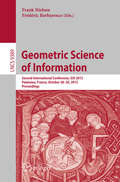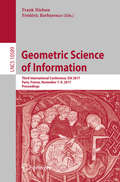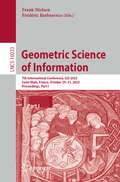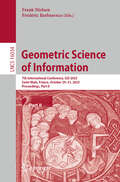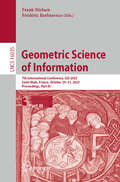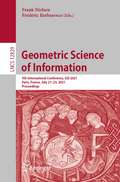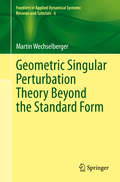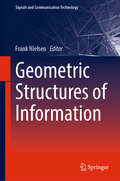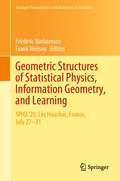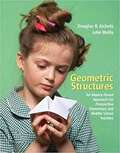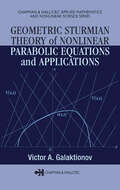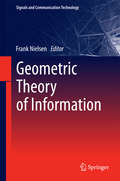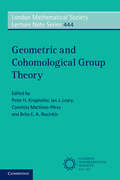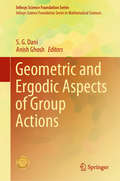- Table View
- List View
Geometric Puzzle Design
by Stewart CoffinThis book discusses how to design "good" geometric puzzles: two-dimensional dissection puzzles, polyhedral dissections, and burrs. It outlines major categories of geometric puzzles and provides examples, sometimes going into the history and philosophy of those examples. The author presents challenges and thoughtful questions, as well as practical d
Geometric Quantization and Applications to Fields and Fluids (SpringerBriefs in Physics)
by V. Parameswaran NairThis open access book explains geometric quantization from a physicist’s perspective. After presenting the general formalism, it delves into several examples reflecting current research interests in high-energy physics and condensed matter physics. Applications explore Chern-Simons theory, theta vacuum, the Hall effect, fluid dynamics, and elements of noncommutative geometry. The content is tailored to appeal to researchers, graduate students, and advanced undergraduates in high-energy physics, particle physics, and mathematical physics. A background in differential geometry and group theory is beneficial for a comprehensive understanding of the discussions.
Geometric Representation Theory and Gauge Theory: Cetraro, Italy 2018 (Lecture Notes in Mathematics #2248)
by Alexander Braverman Michael Finkelberg Andrei Negut Alexei OblomkovThis book offers a review of the vibrant areas of geometric representation theory and gauge theory, which are characterized by a merging of traditional techniques in representation theory with the use of powerful tools from algebraic geometry, and with strong inputs from physics. The notes are based on lectures delivered at the CIME school "Geometric Representation Theory and Gauge Theory" held in Cetraro, Italy, in June 2018. They comprise three contributions, due to Alexander Braverman and Michael Finkelberg, Andrei Negut, and Alexei Oblomkov, respectively. Braverman and Finkelberg’s notes review the mathematical theory of the Coulomb branch of 3D N=4 quantum gauge theories. The purpose of Negut’s notes is to study moduli spaces of sheaves on a surface, as well as Hecke correspondences between them. Oblomkov's notes concern matrix factorizations and knot homology. This book will appeal to both mathematicians and theoretical physicists and will be a source of inspiration for PhD students and researchers.
Geometric Science of Information
by Frank Nielsen Frédéric BarbarescoThis book constitutes the refereed proceedings of the Second International Conference on Geometric Science of Information, GSI 2015, held in Palaiseau, France, in October 2015. The 80 full papers presented were carefully reviewed and selected from 110 submissions and are organized into the following thematic sessions: Dimension reduction on Riemannian manifolds; optimal transport; optimal transport and applications in imagery/statistics; shape space and diffeomorphic mappings; random geometry/homology; Hessian information geometry; topological forms and Information; information geometry optimization; information geometry in image analysis; divergence geometry; optimization on manifold; Lie groups and geometric mechanics/thermodynamics; computational information geometry; Lie groups: novel statistical and computational frontiers; geometry of time series and linear dynamical systems; and Bayesian and information geometry for inverse problems.
Geometric Science of Information
by Frank Nielsen Frédéric BarbarescoThis book constitutes the refereed proceedings of the First International Conference on Geometric Science of Information, GSI 2013, held in Paris, France, in August 2013. The nearly 100 papers presented were carefully reviewed and selected from numerous submissions and are organized into the following thematic sessions: Geometric Statistics on Manifolds and Lie Groups, Deformations in Shape Spaces, Differential Geometry in Signal Processing, Relational Metric, Discrete Metric Spaces, Computational Information Geometry, Hessian Information Geometry I and II, Computational Aspects of Information Geometry in Statistics, Optimization on Matrix Manifolds, Optimal Transport Theory, Probability on Manifolds, Divergence Geometry and Ancillarity, Entropic Geometry, Tensor-Valued Mathematical Morphology, Machine/Manifold/Topology Learning, Geometry of Audio Processing, Geometry of Inverse Problems, Algebraic/Infinite dimensional/Banach Information Manifolds, Information Geometry Manifolds, and Algorithms on Manifolds.
Geometric Science of Information: 7th International Conference, GSI 2025, Saint-Malo, France, October 29–31, 2025, Proceedings, Part I (Lecture Notes in Computer Science #16033)
by Frank Nielsen Frédéric BarbarescoThe 3-volume set LNCS 16033 - 16035 constitutes the proceedings of the 7th International Conference on Geometric Science of Information, GSI 2025, held in St. Malo, France, during October 2025. The main theme of GSI 2025 was: Geometric Structures of Statistical and Quantum Physics, Information Geometry, and Machine Learning: FROM CLASSICAL TO QUANTUM INFORMATION GEOMETRY. The 124 full papers included in the proceedings were carefully reviewed and selected from 146 submissions. They were organized in topical sections as follows: Part I: Geometric Learning and Differential Invariants on Homogeneous Spaces; Statistical Manifolds and Hessian information geometry; Applied Geometry-Informed Machine Learning; Geometric Green Learning on Groups and Quotient Spaces; Divergences in Statistics and Machine Learning; Part II: Geometric Statistics; Computational Information Geometry and Divergences; Geometric Methods in Thermodynamics; Classical & Quantum Information, Geometry and Topology; Geometric Mechanics; Stochastic Geometric Dynamics; Part III: New trends in Nonholonomic Systems; Learning of Dynamic Processes; Optimization and learning on manifolds; Neurogeometry; Lie Group in Learning Distributions & in Filters; A geometric approach to differential equations; Information Geometry, Delzant Toric Manifold & Integrable System.
Geometric Science of Information: 7th International Conference, GSI 2025, Saint-Malo, France, October 29–31, 2025, Proceedings, Part II (Lecture Notes in Computer Science #16034)
by Frank Nielsen Frédéric BarbarescoThe 3-volume set LNCS 16033 - 16035 constitutes the proceedings of the 7th International Conference on Geometric Science of Information, GSI 2025, held in St. Malo, France, during October 2025. The main theme of GSI 2025 was: Geometric Structures of Statistical and Quantum Physics, Information Geometry, and Machine Learning: FROM CLASSICAL TO QUANTUM INFORMATION GEOMETRY. The 124 full papers included in the proceedings were carefully reviewed and selected from 146 submissions. They were organized in topical sections as follows: Part I: Geometric Learning and Differential Invariants on Homogeneous Spaces; Statistical Manifolds and Hessian information geometry; Applied Geometry-Informed Machine Learning; Geometric Green Learning on Groups and Quotient Spaces; Divergences in Statistics and Machine Learning; Part II: Geometric Statistics; Computational Information Geometry and Divergences; Geometric Methods in Thermodynamics; Classical & Quantum Information, Geometry and Topology; Geometric Mechanics; Stochastic Geometric Dynamics; Part III: New trends in Nonholonomic Systems; Learning of Dynamic Processes; Optimization and learning on manifolds; Neurogeometry; Lie Group in Learning Distributions & in Filters; A geometric approach to differential equations; Information Geometry, Delzant Toric Manifold & Integrable System.
Geometric Science of Information: 7th International Conference, GSI 2025, Saint-Malo, France, October 29–31, 2025, Proceedings, Part III (Lecture Notes in Computer Science #16035)
by Frank Nielsen Frédéric BarbarescoThe 3-volume set LNCS 16033 - 16035 constitutes the proceedings of the 7th International Conference on Geometric Science of Information, GSI 2025, held in St. Malo, France, during October 2025. The main theme of GSI 2025 was: Geometric Structures of Statistical and Quantum Physics, Information Geometry, and Machine Learning: FROM CLASSICAL TO QUANTUM INFORMATION GEOMETRY. The 124 full papers included in the proceedings were carefully reviewed and selected from 146 submissions. They were organized in topical sections as follows: Part I: Geometric Learning and Differential Invariants on Homogeneous Spaces; Statistical Manifolds and Hessian information geometry; Applied Geometry-Informed Machine Learning; Geometric Green Learning on Groups and Quotient Spaces; Divergences in Statistics and Machine Learning; Part II: Geometric Statistics; Computational Information Geometry and Divergences; Geometric Methods in Thermodynamics; Classical & Quantum Information, Geometry and Topology; Geometric Mechanics; Stochastic Geometric Dynamics; Part III: New trends in Nonholonomic Systems; Learning of Dynamic Processes; Optimization and learning on manifolds; Neurogeometry; Lie Group in Learning Distributions & in Filters; A geometric approach to differential equations; Information Geometry, Delzant Toric Manifold & Integrable System.
Geometric Science of Information: Third International Conference, Gsi 2017, Paris, France, November 7-9, 2017, Proceedings (Lecture Notes In Computer Science Ser. #10589)
by Frank Nielsen Frédéric BarbarescoThis book constitutes the proceedings of the 5th International Conference on Geometric Science of Information, GSI 2021, held in Paris, France, in July 2021. The 98 papers presented in this volume were carefully reviewed and selected from 125 submissions. They cover all the main topics and highlights in the domain of geometric science of information, including information geometry manifolds of structured data/information and their advanced applications. The papers are organized in the following topics: Probability and statistics on Riemannian Manifolds; sub-Riemannian geometry and neuromathematics; shapes spaces; geometry of quantum states; geometric and structure preserving discretizations; information geometry in physics; Lie group machine learning; geometric and symplectic methods for hydrodynamical models; harmonic analysis on Lie groups; statistical manifold and Hessian information geometry; geometric mechanics; deformed entropy, cross-entropy, and relative entropy; transformation information geometry; statistics, information and topology; geometric deep learning; topological and geometrical structures in neurosciences; computational information geometry; manifold and optimization; divergence statistics; optimal transport and learning; and geometric structures in thermodynamics and statistical physics.
Geometric Singular Perturbation Theory Beyond the Standard Form (Frontiers in Applied Dynamical Systems: Reviews and Tutorials #6)
by Martin WechselbergerThis volume provides a comprehensive review of multiple-scale dynamical systems. Mathematical models of such multiple-scale systems are considered singular perturbation problems, and this volume focuses on the geometric approach known as Geometric Singular Perturbation Theory (GSPT). It is the first of its kind that introduces the GSPT in a coordinate-independent manner. This is motivated by specific examples of biochemical reaction networks, electronic circuit and mechanic oscillator models and advection-reaction-diffusion models, all with an inherent non-uniform scale splitting, which identifies these examples as singular perturbation problems beyond the standard form. The contents cover a general framework for this GSPT beyond the standard form including canard theory, concrete applications, and instructive qualitative models. It contains many illustrations and key pointers to the existing literature. The target audience are senior undergraduates, graduate students and researchers interested in using the GSPT toolbox in nonlinear science, either from a theoretical or an application point of view. Martin Wechselberger is Professor at the School of Mathematics & Statistics, University of Sydney, Australia. He received the J.D. Crawford Prize in 2017 by the Society for Industrial and Applied Mathematics (SIAM) for achievements in the field of dynamical systems with multiple time-scales.
Geometric Structures of Information (Signals and Communication Technology)
by Frank NielsenThis book focuses on information geometry manifolds of structured data/information and their advanced applications featuring new and fruitful interactions between several branches of science: information science, mathematics and physics. It addresses interrelations between different mathematical domains like shape spaces, probability/optimization & algorithms on manifolds, relational and discrete metric spaces, computational and Hessian information geometry, algebraic/infinite dimensional/Banach information manifolds, divergence geometry, tensor-valued morphology, optimal transport theory, manifold & topology learning, and applications like geometries of audio-processing, inverse problems and signal processing. The book collects the most important contributions to the conference GSI’2017 – Geometric Science of Information.
Geometric Structures of Statistical Physics, Information Geometry, and Learning
by Frank Nielsen Frédéric BarbarescoMachine learning and artificial intelligence increasingly use methodological tools rooted in statistical physics. Conversely, limitations and pitfalls encountered in AI question the very foundations of statistical physics. This interplay between AI and statistical physics has been attested since the birth of AI, and principles underpinning statistical physics can shed new light on the conceptual basis of AI. During the last fifty years, statistical physics has been investigated through new geometric structures allowing covariant formalization of the thermodynamics. Inference methods in machine learning have begun to adapt these new geometric structures to process data in more abstract representation spaces. <P><P> This volume collects selected contributions on the interplay of statistical physics and artificial intelligence. The aim is to provide a constructive dialogue around a common foundation to allow the establishment of new principles and laws governing these two disciplines in a unified manner. The contributions were presented at the workshop on the Joint Structures and Common Foundation of Statistical Physics, Information Geometry and Inference for Learning which was held in Les Houches in July 2020. The various theoretical approaches are discussed in the context of potential applications in cognitive systems, machine learning, signal processing.
Geometric Structures: An Inquiry-Based Approach for Prospective Elementary and Middle School Teachers
by Douglas Aichele John WolfeFor prospective elementary and middle school teachers. This text provides a creative, inquiry-based experience with geometry that is appropriate for prospective elementary and middle school teachers. The coherent series of text activities supports each student’s growth toward being a confident, independent learner empowered with the help of peers to make sense of the geometric world. This curriculum is explicitly developed to provide future elementary and middle school teachers with experience recalling and appropriately using standard geometry ideas, experience learning and making sense of new geometry, experience discussing geometry with peers, experience asking questions about geometry, experience listening and understanding as others talk about geometry, experience gaining meaning from reading geometry, experience expressing geometry ideas through writing, experience thinking about geometry, and experience doing geometry. These activities constitute an “inquiry based” curriculum. In this style of learning and teaching, whole class discussions and group work replace listening to lectures as the dominant class activity.
Geometric Sturmian Theory of Nonlinear Parabolic Equations and Applications (Chapman & Hall/CRC Applied Mathematics & Nonlinear Science)
by Victor A. GalaktionovUnlike the classical Sturm theorems on the zeros of solutions of second-order ODEs, Sturm's evolution zero set analysis for parabolic PDEs did not attract much attention in the 19th century, and, in fact, it was lost or forgotten for almost a century. Briefly revived by P�lya in the 1930's and rediscovered in part several times since, it was not un
Geometric Theory of Information
by Frank NielsenThis book brings together geometric tools and their applications for Information analysis. It collects current and many uses of in the interdisciplinary fields of Information Geometry Manifolds in Advanced Signal, Image & Video Processing, Complex Data Modeling and Analysis, Information Ranking and Retrieval, Coding, Cognitive Systems, Optimal Control, Statistics on Manifolds, Machine Learning, Speech/sound recognition and natural language treatment which are also substantially relevant for the industry.
Geometric and Analytic Aspects of Functional Variational Principles: Cetraro, Italy 2022 (Lecture Notes in Mathematics #2348)
by Giuseppe Mingione Rupert Frank Lubos Pick Ovidiu Savin Jean Van SchaftingenThis book is dedicated to exploring optimization problems of geometric-analytic nature, which are fundamental to tackling various unresolved questions in mathematics and physics. These problems revolve around minimizing geometric or analytic quantities, often representing physical energies, within prescribed collections of sets or functions. They serve as catalysts for advancing methodologies in calculus of variations, partial differential equations, and geometric analysis. Furthermore, insights from optimal functional-geometric inequalities enhance analytical problem-solving endeavors. The contributions focus on the intricate interplay between these inequalities and problems of differential and variational nature. Key topics include functional and geometric inequalities, optimal norms, sharp constants in Sobolev-type inequalities, and the regularity of solutions to variational problems. Readers will gain a comprehensive understanding of these concepts, deepening their appreciation for their relevance in mathematical and physical inquiries.
Geometric and Cohomological Group Theory (London Mathematical Society Lecture Note Series #444)
by Ian J. Leary Peter H. Kropholler Conchita Martínez-Pérez BRITA E.A. NUCINKISThis volume provides state-of-the-art accounts of exciting recent developments in the rapidly-expanding fields of geometric and cohomological group theory. The research articles and surveys collected here demonstrate connections to such diverse areas as geometric and low-dimensional topology, analysis, homological algebra and logic. Topics include various constructions of Thompson-like groups, Wise's theory of special cube complexes, groups with exotic homological properties, the Farrell-Jones assembly conjectures and new applications of Garside structures. Its mixture of surveys and research makes this book an excellent entry point for young researchers as well as a useful reference work for experts in the field. This is the proceedings of the 100th meeting of the London Mathematical Society series of Durham Symposia.
Geometric and Ergodic Aspects of Group Actions (Infosys Science Foundation Series)
by S. G. Dani Anish GhoshThis book gathers papers on recent advances in the ergodic theory of group actions on homogeneous spaces and on geometrically finite hyperbolic manifolds presented at the workshop “Geometric and Ergodic Aspects of Group Actions,” organized by the Tata Institute of Fundamental Research, Mumbai, India, in 2018. Written by eminent scientists, and providing clear, detailed accounts of various topics at the interface of ergodic theory, the theory of homogeneous dynamics, and the geometry of hyperbolic surfaces, the book is a valuable resource for researchers and advanced graduate students in mathematics.
Geometric and Harmonic Analysis on Homogeneous Spaces and Applications: TJC 2015, Monastir, Tunisia, December 18-23 (Springer Proceedings in Mathematics & Statistics #207)
by Ali Baklouti Takaaki NomuraThis book provides the latest competing research results on non-commutative harmonic analysis on homogeneous spaces with many applications. It also includes the most recent developments on other areas of mathematics including algebra and geometry.Lie group representation theory and harmonic analysis on Lie groups and on their homogeneous spaces form a significant and important area of mathematical research. These areas are interrelated with various other mathematical fields such as number theory, algebraic geometry, differential geometry, operator algebra, partial differential equations and mathematical physics. Keeping up with the fast development of this exciting area of research, Ali Baklouti (University of Sfax) and Takaaki Nomura (Kyushu University) launched a series of seminars on the topic, the first of which took place on November 2009 in Kerkennah Islands, the second in Sousse on December 2011, and the third in Hammamet on December 2013. The last seminar, which took place December 18th to 23rd 2015 in Monastir, Tunisia, has promoted further research in all the fields where the main focus was in the area of Analysis, algebra and geometry and on topics of joint collaboration of many teams in several corners. Many experts from both countries have been involved.
Geometric and Harmonic Analysis on Homogeneous Spaces: TJC 2017, Mahdia, Tunisia, December 17–21 (Springer Proceedings in Mathematics & Statistics #290)
by Ali Baklouti Takaaki NomuraThis book presents a number of important contributions focusing on harmonic analysis and representation theory of Lie groups. All were originally presented at the 5th Tunisian–Japanese conference “Geometric and Harmonic Analysis on Homogeneous Spaces and Applications”, which was held at Mahdia in Tunisia from 17 to 21 December 2017 and was dedicated to the memory of the brilliant Tunisian mathematician Majdi Ben Halima. The peer-reviewed contributions selected for publication have been modified and are, without exception, of a standard equivalent to that in leading mathematical periodicals. Highlighting the close links between group representation theory and harmonic analysis on homogeneous spaces and numerous mathematical areas, such as number theory, algebraic geometry, differential geometry, operator algebra, partial differential equations and mathematical physics, the book is intended for researchers and students working in the area of commutative and non-commutative harmonic analysis as well as group representations.
Geometric and Numerical Optimal Control: Application to Swimming at Low Reynolds Number and Magnetic Resonance Imaging (SpringerBriefs in Mathematics)
by Bernard Bonnard Monique Chyba Jérémy RouotThis book introduces readers to techniques of geometric optimal control as well as the exposure and applicability of adapted numerical schemes. It is based on two real-world applications, which have been the subject of two current academic research programs and motivated by industrial use – the design of micro-swimmers and the contrast problem in medical resonance imaging. The recently developed numerical software has been applied to the cases studies presented here. The book is intended for use at the graduate and Ph.D. level to introduce students from applied mathematics and control engineering to geometric and computational techniques in optimal control.
Geometric and Topological Aspects of the Representation Theory of Finite Groups: Pims Summer School And Workshop, July 27-august 5 2016 (Springer Proceedings in Mathematics & Statistics #242)
by Jon F. Carlson Srikanth B. Iyengar Julia PevtsovaThese proceedings comprise two workshops celebrating the accomplishments of David J. Benson on the occasion of his sixtieth birthday. The papers presented at the meetings were representative of the many mathematical subjects he has worked on, with an emphasis on group prepresentations and cohomology. The first workshop was titled "Groups, Representations, and Cohomology" and held from June 22 to June 27, 2015 at Sabhal Mòr Ostaig on the Isle of Skye, Scotland. The second was a combination of a summer school and workshop on the subject of "Geometric Methods in the Representation Theory of Finite Groups" and took place at the Pacific Institute for the Mathematical Sciences at the University of British Columbia in Vancouver from July 27 to August 5, 2016. The contents of the volume include a composite of both summer school material and workshop-derived survey articles on geometric and topological aspects of the representation theory of finite groups. The mission of the annually sponsored Summer Schools is to train and draw new students, and help Ph.D students transition to independent research.
Geometric and Topological Inference (Cambridge Texts in Applied Mathematics #57)
by Jean-Daniel Boissonnat Frédéric Chazal Mariette YvinecGeometric and topological inference deals with the retrieval of information about a geometric object using only a finite set of possibly noisy sample points. It has connections to manifold learning and provides the mathematical and algorithmic foundations of the rapidly evolving field of topological data analysis. Building on a rigorous treatment of simplicial complexes and distance functions, this self-contained book covers key aspects of the field, from data representation and combinatorial questions to manifold reconstruction and persistent homology. It can serve as a textbook for graduate students or researchers in mathematics, computer science and engineering interested in a geometric approach to data science.
Geometric and Topological Mesh Feature Extraction for 3D Shape Analysis
by Jean-Luc Mari Franck Hétroy-Wheeler Gérard SubsolThree-dimensional surface meshes are the most common discrete representation of the exterior of a virtual shape. Extracting relevant geometric or topological features from them can simplify the way objects are looked at, help with their recognition, and facilitate description and categorization according to specific criteria. This book adopts the point of view of discrete mathematics, the aim of which is to propose discrete counterparts to concepts mathematically defined in continuous terms. It explains how standard geometric and topological notions of surfaces can be calculated and computed on a 3D surface mesh, as well as their use for shape analysis. Several applications are also detailed, demonstrating that each of them requires specific adjustments to fit with generic approaches. The book is intended not only for students, researchers and engineers in computer science and shape analysis, but also numerical geologists, anthropologists, biologists and other scientists looking for practical solutions to their shape analysis, understanding or recognition problems.
Geometrical Formulation of Renormalization-Group Method as an Asymptotic Analysis: With Applications to Derivation of Causal Fluid Dynamics (Fundamental Theories of Physics #206)
by Teiji Kunihiro Yuta Kikuchi Kyosuke TsumuraThis book presents a comprehensive account of the renormalization-group (RG) method and its extension, the doublet scheme, in a geometrical point of view. It extract long timescale macroscopic/mesoscopic dynamics from microscopic equations in an intuitively understandable way rather than in a mathematically rigorous manner and introduces readers to a mathematically elementary, but useful and widely applicable technique for analyzing asymptotic solutions in mathematical models of nature. The book begins with the basic notion of the RG theory, including its connection with the separation of scales. Then it formulates the RG method as a construction method of envelopes of the naive perturbative solutions containing secular terms, and then demonstrates the formulation in various types of evolution equations. Lastly, it describes successful physical examples, such as stochastic and transport phenomena including second-order relativistic as well as nonrelativistic fluid dynamics with causality and transport phenomena in cold atoms, with extensive numerical expositions of transport coefficients and relaxation times. Requiring only an undergraduate-level understanding of physics and mathematics, the book clearly describes the notions and mathematical techniques with a wealth of examples. It is a unique and can be enlightening resource for readers who feel mystified by renormalization theory in quantum field theory.
